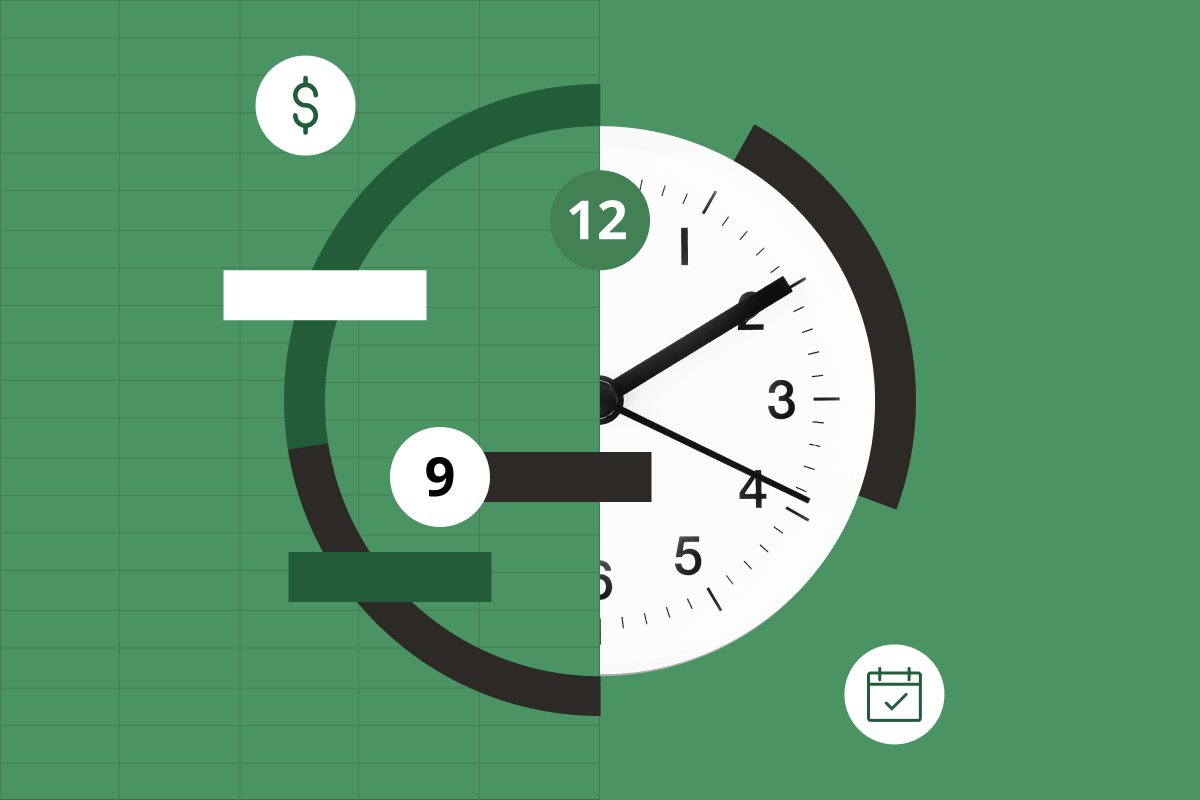Finance teams simply can’t afford to sit still and rely on static data or forecasts as market conditions change, often on a daily basis.
Instead, they need to take on a more dynamic approach and use tools ready to adapt as quickly as their business.
One way to do that is by implementing rolling forecasts. Rolling forecasts allow companies to make better, faster, data-driven decisions. They allow for dynamic, not static, planning.
In this blog, we’ll unpack why more businesses are opting for rolling forecasts over a traditional static budgeting or forecasting approach, and walk you through how to create a rolling forecast.
What Is a Rolling Forecast?
Rolling forecasts do exactly what they say: they’re a continuous, dynamic view of the business’s projected revenue, expenses, cash metrics and more. Rolling forecasts can be updated at set periods—whether it be quarterly, monthly or even weekly.
By adding and dropping a week, month or quarter every cycle, a rolling forecast allows you to maintain visibility ahead, well past the traditional static budgeting timeframe of a fiscal year.
“A rolling forecast is a more extended and detailed way to think about annual planning,” said Igor Stelea, Director of Strategic Finance, Analytics & Business Transformation at CFGI, on an episode of The CFO Show podcast. The key, Igor said, is to be able to incorporate updated data on the fly, “which gives teams better insight into how well they can perform.”
Rolling forecasting brings agility to your budgeting and forecasting practices and enhances your organization’s forward visibility. By extending your budget past a fixed timeframe, you can continue to update across fiscal years.
And as with any forecasting process, a rolling forecast enables you to evaluate resources and project allocations on a more ongoing basis, making it easier to map budget to current performance.
You can check out Vena’s downloadable rolling forecast template to get a sense of what a rolling forecast looks like.
Industry data shows that around a quarter of firms globally use some form of rolling forecasts, and that number is likely to rise.
How To Create a Rolling Forecast: 6 Steps

A view of Vena’s downloadable rolling forecast template for Excel, allowing you to choose from a variety of planning methods to forecast salaries, amortization and depreciation, operating expenses and more.
Here’s how to create a rolling forecast, step by step.
1. Define Your Drivers
“Drivers” are the operational levers that determine outcomes in your business. Defining drivers means connecting measurable inputs, such as headcounts or average revenues, to outputs, like cash flow or expenses. You can then iterate on your rolling forecast as strategic goals and drivers change, ensuring the right resources are available to meet your organization's ongoing goals.
“For companies focused on revenue growth, their number one metric is going to be revenue growth, and then maybe some other KPIs like cost of goods sold, gross margin, EBITDA, depending on the maturity of the company,” said Igor.
For the manufacturer Aurora Plastics, the most important drivers for their forecast were sales by SKU, sales representative and customer segment. With detailed real-time transaction-level sales data populating in Vena, Aurora Plastics’ finance team was able to forecast further out, going from a one-month view of demand to a 12-month view. Now with a better long-range view of predicted sales, Aurora Plastics can buy raw materials with greater cost efficiency and forecast commissions with greater accuracy.
2. Select a Horizon
Whether you choose to forecast quarterly, monthly or weekly, the timeframe should match the rate at which your company is evaluating progress—as well as the pace of the industry around you.
For example, prior to implementing Vena, the pet health and wellness company PetIQ was somewhat stuck with a static budget and ad hoc forecasts that relied only on qualitative feedback. But since bringing their budgets into Vena as their source of truth, the PetIQ team has found that a nine-month rolling forecast works well for them, with opportunities throughout the year to revisit it.
“We do a formal reforecast effort every quarter and sometimes more often, due to consumer spending changes, wins or losses in our customer and product base, or any other significant macro changes,” said Pat Jones, Senior Vice-President and Corporate Controller at PetIQ.
3. Automate Data Pulls
With a timeframe selected and drivers in mind, it’s time to put your team into action. Automate data pulls to correspond with your chosen time horizon. To have your rolling forecasts update automatically (as is the goal, and where the value of a rolling forecast lies), this will depend on the technology you choose to put in place.
“ When you have a planning tool, it's very easy to create new scenarios and open up a new period for the rolling forecast,” said Igor. “When you just do it manually in Excel, it can become a logistical and mechanical nightmare. The teams that I do see successfully rolling out those rolling forecasts are the ones that are implementing best practices around budgeting and have really good hygiene around budgeting and forecasting.”
“That also comes with having the ability to get historical data quickly. Because if you can't, you're stuck with one quarter of actuals data that you're bringing in and you're just spending too much time on that. So you need to be able to bring in the data quickly and to nimbly do analysis on the fly—then you could do a true rolling forecast, which gives teams and companies better insights into how well they can perform and tie it even closer to the strategic plan.”
TIP: A Corporate Performance Management (CPM) platform like Vena with pre-built connectors to your core systems like your ERP can consolidate your data sources into a single, flexible database, allowing you to direct your data through your rolling forecast automatically.
4. Set Your Update Cadence
You’ll need to determine the right cadence for your data updates, as well as how often you’re communicating those updates, to ensure your forecasts are as relevant as possible to stakeholders.
It will also ensure that you have buy-in early on longer-term commitments around cash management, inventory management and new hires. Leveraging technology makes rolling your plan a simple lift and empowers your people to run an efficient and effective rolling forecast process.
5. Align Stakeholders
Perhaps the primary goal of the forecasting process is to build transparency and accountability, so your data becomes more useful to teams and key stakeholders across the organization. You’ll want to align those stakeholders early, incorporating their goals and priorities into your processes so that they’re getting what they need.
One of the most common pitfalls Igor sees businesses encounter when delivering their annual planning is a lack of shared ownership caused by siloed operations.
“ Where there's a lot of disconnect, even after the budget is done and you go into re-forecasting, nobody takes ownership for their numbers or if they're asked to find risks and opportunities in their budgets, there can be a lot of blame sharing that goes around,” he said.
“Don’t just send out email templates in a vacuum to your business partners on the functional side and the operational side. Instead, they should be more involved in the process and planning cross-functional sprints, with Finance being more of a facilitator versus just dictating numbers.”
6. Review and Iterate
Use dashboards and visualizations to track execution against your rolling forecast so that you can see how it keeps up with ongoing performance. In doing so, you'll be able to make any necessary iterations along the way—and ensure your progress stays transparent across your business.
Igor also highlighted the importance of challenging assumptions when creating and reviewing operating plans.
“ Challenging every assumption from last year's plan and really investing into those rolling forecasts, I think will pay dividends because it allows finance to be a bridge [to the rest of the business] and just be more agile,” he said.
Rolling Forecasts vs. Static Budgets
Rolling forecasts are dynamic. They incorporate the newest available data and continuously update it into the next fiscal year. They stand in stark contrast to static budgets, which are created a single time and receive minimal updates based on new developments. That puts organizations at a disadvantage when the business environment is in constant flux.
Despite the advantages of rolling forecasts, static budgets remain a common practice among finance teams.
But in high-growth companies or large organizations with a lot of moving parts—or amidst evolving market or industry changes—traditional budgets and intra-year forecasts may not be enough to keep up. Rolling forecasts fill that gap.
They help to maintain visibility into recent performance while better projecting future needs. They may allow quick-moving companies to remain agile to new trends and requirements while continuing to move the planning horizon forward.
Of course, it's not actually an either/or approach. You can opt to implement both static budgets and rolling forecasts—or you might even be required to have both so that you can offer a full view of company performance to your board, investors or stakeholders. In those cases, rolling forecasts become an extension of your annual budgeting process.
You can choose to introduce them as a process of review at regular intervals to keep up with current performance and changing market conditions. Or you can apply them only to certain areas, such as revenue or cash planning, with a more traditional approach used elsewhere.
Naturally, rolling forecasts have their advantages and disadvantages, too, which are worth exploring.
The Benefits of Rolling Forecasts
Without having to wait a full year to revisit your budget, rolling forecasts let you plan for both the short and long term—always with a view into the future, several months ahead. Consider the benefits of rolling forecasts:
-
They help you stay ahead: Unlike traditional budgets, which are based primarily on past results, rolling forecasts enable you to consider current operational drivers, such as customer satisfaction, market share, and category growth, to stay ahead of market and business changes.
-
They improve accuracy: A static budget risks becoming out of date within months—or even days if the market unexpectedly changes. But a rolling forecast gives you a constant outlook, allowing you to adjust quickly so that you have the right resources in place to keep up.
-
They mitigate risk: By maintaining a consistent horizon for your forward-looking outlook forecast, you'll be better positioned to keep your plan aligned to current performance, recognize risks to your business and make appropriate course corrections.
-
They help you make better decisions: With a more up-to-date eye on your forecast, you'll also have a better understanding of when to take risks—for example, putting resources into a new growth initiative—or when staying the course is a better game plan. Also, areas of the business that work on a longer time horizon will no longer do so in a vacuum, becoming part of the bigger picture instead. Finally, they enable cross-functional collaboration, a crucial facet in ensuring rolling forecasts are producing accurate results.
The Challenges of Introducing Rolling Forecasts
While the benefits are numerous, some potential obstacles can get in the way of implementing rolling forecasts. Keep these in mind if you're considering introducing rolling forecasts into your business.
Rolling Forecasts Require Added Investments of Time and Money
To be successful, rolling forecasts require technology and training investments, as well as extra time from your team to put the best processes in place and to keep them running smoothly. Be prepared to justify the extra expenditures.
Success Is Dependent on Company Culture
For rolling forecasting to work, you need your senior managers to not only support the endeavor but also to update their own forecasts on a rolling basis, which means adding to their already busy workload. But managers can benefit from the process as well: funding requests don't need to be restricted to just once a year, for instance. Helping them understand that can get them on board.
They Depend on Clean Data
You need a constant flow of performance data to inform your rolling forecasts. That data allows you to compare actuals to forecasts and ensure your plans are on track. It's no surprise, then, that companies can let a lack of clean, actionable data get in the way of introducing rolling forecasting. Waiting for the data to be perfect, though, isn't the answer either.
Understanding the potential challenges to introducing rolling forecasts can help you mitigate risk upfront and reduce friction for partners across the business.
Get Rolling With Vena
Once you've established a new normal, rolling forecasts can give you exactly the agility and insight you need to help your business thrive—and ensure you're ready for whatever is ahead.
Learn how Vena can help power your rolling forecasts.








